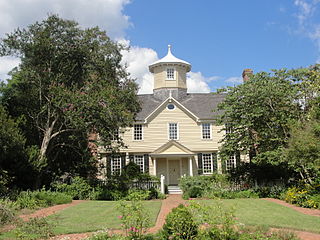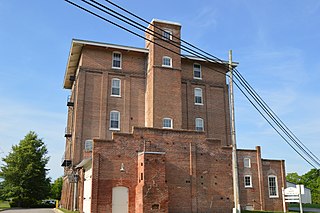
Edenton is a town in, and the county seat of, Chowan County, North Carolina, United States, on Albemarle Sound. The population was 4,397 at the 2020 census. Edenton is located in North Carolina's Inner Banks region. In recent years Edenton has become a popular retirement location and a destination for heritage tourism.

The Chowan County Courthouse is a historic courthouse in Edenton, the county seat of Chowan County, North Carolina. Built in 1767, it is one of the finest examples of public Georgian architecture in the American South. It was declared a National Historic Landmark in 1970.

The Cupola House is a historic house museum in Edenton, North Carolina. Built in 1756–1758, it is the second oldest building in Edenton, and the only known surviving example in the American South of a "jutt," or overhanging second floor. It was declared a National Historic Landmark in 1970.

Hayes Plantation, also known as Hayes Farm, is a historic plantation near Edenton, North Carolina that belonged to Samuel Johnston (1733–1816), who served as Governor of North Carolina from 1787 to 1789. Johnston became one of the state's first two United States Senators, serving from 1789 until 1793, and served later as a judge until retiring in 1803. Samuel Johnston died in 1816 at "the Hermitage," his home near Williamston in Martin County, N.C. The residence known as Hayes was completed by his son, James Cathcart Johnston, a year after Samuel's death. There are numerous other structures on the property, some predating the Hayes house itself, including the Hayes Gatehouse, which James Johnston lived in prior to the construction of the Hayes house.

The Capitol Area Historic District is a national historic district located at Raleigh, North Carolina. The district encompasses 25 contributing buildings and was developed after 1792. The district includes notable examples of Classical Revival and Late Gothic Revival style architecture. Located in the district are the following separately listed buildings:

Edenton Historic District is a national historic district located at Edenton, Chowan County, North Carolina. The district encompasses 342 contributing buildings, 4 contributing sites, and 3 contributing structures. It includes several buildings that are individually listed on the National Register. The Lane House, possibly the oldest surviving house in North Carolina, is owned by Steve and Linda Lane and is located within the district. Also located in the district are the Dixon-Powell House, William Leary House, and Louis Ziegler House designed by architect George Franklin Barber.

The St. Paul A.M.E. Church is a historic American Gothic Revival style African Methodist Episcopal Church located in Raleigh, North Carolina. A red brick and frame structure built in 1884 by black masons, St. Paul's was the first independent congregation of African Americans in Raleigh and is the oldest African-American church in Wake County, North Carolina. Before the end of the Civil War, the future founders of St. Paul's had been slave members of the Edenton Street United Methodist Church. The members of the church began calling their congregation "St. Paul's" in 1848. The church was listed on the National Register of Historic Places in November 1987 and is also a Raleigh Historic Landmark.

Maybury Hill is a historic house at 346 Snowden Lane, in Princeton, Mercer County, New Jersey, United States. Built about 1725, it was the birthplace and boyhood home of Joseph Hewes (1730-1799), a signer of the United States Declaration of Independence. The house, an architecturally excellent example of Georgian domestic architecture, was designated a National Historic Landmark in 1971 for its association with Hewes. It is a private residence not open to the public.

The James Iredell House is a historic home located at Edenton, Chowan County, North Carolina. The original section was built 1800, and expanded to its present configuration about 1827. It is a two-story, "L"-shaped frame dwelling with Georgian and Federal style design elements. It was the home of James Iredell, an ardent patriot and Justice of the Supreme Court.

St. Paul's Church, Edenton, is a historic parish church in Edenton, North Carolina. The building, which dates from 1760, is listed on the National Register of Historic Places. The churchyard has the tombs of governors Charles Eden (1673–1722), Thomas Pollock (1654–1722), and Gabriel Johnston (1699–1752).
John Hawks was a British-born American architect remembered as the dominant force in North Carolinian architecture for two decades, and a major designer of some of New Bern's most notable structures. He also served as the first auditor of North Carolina from 1784 until his death.

Athol, also known as Benbury Hall and Joshua Skinner House, is a historic plantation house located near Edenton, Chowan County, North Carolina. It was built about 1857, and is a 2+1⁄2-story, five bay, "T"-shaped Greek Revival style frame dwelling. The rear section of the house features two-tier porches on either side. The front facade features a full-length two-tiered porch supported by Roman Ionic order columns.

Barker House is a historic home located at Edenton, Chowan County, North Carolina. The original house was built about 1782, and expanded during the 19th century. It is a 2+1⁄2-story frame dwelling with Georgian, Federal, and Greek Revival style design elements. It sits on a brick foundation and has at both ends a pair of single-shoulder exterior chimneys. The front facade features a full-length, two-tier porch carried on superimposed fluted pillars under a shed roof.

Mulberry Hill is a historic plantation house located near Edenton, Chowan County, North Carolina. It was built about 1810, and is a 2+1⁄2-story, three bay, Federal style brick dwelling with a side-hall plan.

Sandy Point is a historic plantation house located near Edenton, Chowan County, North Carolina. It was built about 1810 and later expanded. It is a 2 1/2-story, five bay, Federal / Greek Revival style frame dwelling with a center hall plan. The front facade features a two-tiered full-length porch and the house has two exterior end chimneys at each side.

Wessington House is a historic home located at Edenton, Chowan County, North Carolina. It was built about 1851, and is a 3-story house with a full English basement, brick dwelling with a center hall plan. The front facade features a two-tiered full-length porch with elaborate iron railings and balustrade.
Speight House and Cotton Gin is a historic home and cotton gin located at Edenton, Chowan County, North Carolina. It was built in 1900, and is a two-story, "L"-shaped, Queen Anne-style brick dwelling with a hipped roof. It features three full-height projecting demi-octagonal bays and spacious wraparound verandah. The cotton gin was built about 1901–1902, and is a brick "L"-shaped building with a one-story main block and two-story ell. Also on the property are a contributing smokehouse and other dependencies.

Edenton Cotton Mill Historic District is a national historic district located at Edenton, Chowan County, North Carolina. The district encompasses 70 contributing buildings, 1 contributing site, 2 contributing structures, and 1 contributing object in a small mill village. It includes industrial and residential buildings developed between 1899 and 1923. Residential buildings are primarily simple one-story, single-pile, frame dwellings and some examples of the Bungalow / American Craftsman style. Notable non-residential buildings include the Italianate Revival style Edenton Cotton Mill (1899-1916), Edenton Cotton Mill Office, and First Christian Church (1916).
Edenton Station, United States Fish and Fisheries Commission, formerly known as Edenton National Fish Hatchery, is a historic fish hatchery and national historic district located at Edenton, Chowan County, North Carolina. The district encompasses 17 contributing buildings, 2 contributing sites, 17 contributing structures, and 2 contributing objects. It was established in 1899 by the United States Fish and Fisheries Commission and operated by the federal government until 1954, then sold to private owners in 1961. The hatchery was operated by the Bureau of Fisheries. During the 1930s, the Public Works Administration and Works Progress Administration funded a number of building projects at the hatchery. Notable contributing resources include the Superintendent's House (1900), Fish Culturist's House (1938-1939), terrace (1899-1900), Pump House No. 1, Pump House No. 2, Water Tank (1929), 10 Fish Ponds, Flag Pole (1922-1923), and Daphnia Pools (1939-1940).



















